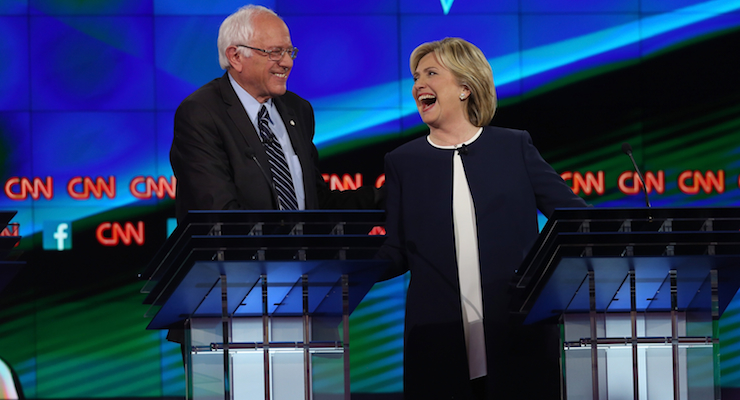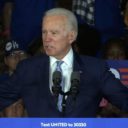

LAS VEGAS, NV – OCTOBER 13: Democratic presidential candidates Sen. Bernie Sanders (I-VT) (L) and Hillary Clinton take part in a presidential debate sponsored by CNN and Facebook at Wynn Las Vegas on October 13, 2015 in Las Vegas, Nevada. Five Democratic presidential candidates are participating in the party’s first presidential debate. (Photo by Joe Raedle/Getty Images)
Hillary Clinton and Bernie Sanders are basically two peas in a pod on economic policy. The only difference is that Sanders wants America to become Greece at a faster rate.
Folks on the left may get excited by whether we travel 60 mph in the wrong direction or 90 mph in the wrong direction, but this seems like a Hobson’s choice for those of us who would prefer that America become more like Hong Kong or Singapore.
Consider the issue of taxation. Clinton and Sanders both agree that they want to raise tax rates on investors, entrepreneurs, small business owners, and other “rich” taxpayers. The only difference is how high and how quickly.
Scott Winship of the Manhattan Institute has a must-read column on this topic in today’s Wall Street Journal.
He starts by speculating whether there’s a rate high enough to satisfy the greed of these two politicians.
Here is a question to ask Hillary Clinton and Bernie Sanders: What is the best tax rate to impose on high-income earners…? Perhaps they think it is 83%, a rate that economists Thomas Piketty and Emmanuel Saez hypothesized in 2014… Or maybe it is 90%, which Sen. Sanders told CNBC last May was not out of the question.
He then points out that there were very high tax rates in America between World War II and the Reagan era.
…the U.S. had such rates in the past. From 1936 to 1980, the highest federal income-tax rate was never below 70%, and the top rate exceeded 90% from 1951 to 1963. …The discussion of these rates can easily create the impression that the federal government collected far more money from “the rich” before the Reagan administration.
But rich people aren’t fatted calves awaiting slaughter. They generally are smart enough to figure out ways to avoid high tax rates. And if they’re not smart enough, they know to hire bright lawyers, lobbyists, and accountants who figure out ways to protect their income.
Which is exactly what happened.
The effective tax rates actually paid by the highest income earners during the 1950s and early ’60s were far lower than the highest marginal rates. …In the 1960s, for example, the average rate paid by the top 0.1% of tax filers—the top 10th of the top 1%—ranged from 26.5% to 29.5%, according to a 2007 study by Messrs. Piketty and Saez. Even during the 20 years after the Reagan tax cuts, the top 10th of the top 1% paid an average rate of 23.7% to 33%—essentially the same as in the 1960s.
Gee, sounds like Hauser’s Law – a limit on how much governments can tax – is true, at least for upper-income taxpayers.
And Winship provides some data showing that high tax rate are not the way to collect more revenue.
When average tax rates went up from 27.6% in 1965 to 34% in 1975, revenues went down, from 0.6% to 0.5% of the sum of GDP plus capital gains. When average tax rates declined to 23.7% over the second half of the 1970s and the ’80s, tax revenues from the top went up, reaching 0.8% of GDP plus capital gains in 1990. …in the early 1990s, Presidents George H.W. Bush and Bill Clinton raised average tax rates at the top, and revenue from the top 0.1% eventually skyrocketed. But the flood of revenue overwhelmingly reflected not the increase in rates but the stock market’s takeoff… Consider: If the higher top tax rates had caused the growth in revenue, then revenues should have fallen when Mr. Clinton cut the top tax rate on capital gains to 20% from 28% in 1997. But revenues from the top 0.1% kept pouring in.
And if you want more detail, check out the IRS data from the 1980s, which shows that rich taxpayers paid a lot more tax when  the top rate was dropped from 70 percent to 28 percent.
the top rate was dropped from 70 percent to 28 percent.
That was a case of the Laffer Curve on steroids!
No wonder some leftists admitthat spite is their real reason for supporting confiscatory tax rates on the rich, not revenue.
But what if the high tax rates are imposed on a much bigger share of the population, not just the traditional target of the “top 1 percent”?
Well, even hardcore statists who favor punitive tax policy admit that this would be a recipe for economic calamity.
Mr. Piketty said, “I firmly believe, that imposing a 70% or 80% marginal rate on large segments of the population (say, 25% of the population, or even 10%, or even a few percentage points) would lead to an economic disaster.” In other words, sayonara increased tax revenue.
Heck, even the European governments with the biggest welfare states rarely impose tax rates at those levels.
And when they do (as in the case of Hollande’s 75 percent tax rate in France), they suffer severe consequences.
Which is why the real difference in taxation between the United States and Europe isn’t the way the rich are taxed. Government is bigger in Europe because of higher tax burdens on the poor and middle class, specifically onerous value-added taxes and top income tax rates that take effect at relatively modest levels of income.
Government is bigger in Europe because of higher tax burdens on the poor and middle class, specifically onerous value-added taxes and top income tax rates that take effect at relatively modest levels of income.
In other words, the rich already pay the lion’s share of tax in the United States. But not because we have 1970s-style tax rates, but because the tax burden is relatively modest for lower- and middle-income people.
Which brings us to Winship’s final point.
Proposals to soak the rich by raising their tax rates are unlikely to yield the revenue windfall that Mr. Sanders or Mrs. Clinton are dangling before voters. Leveling with the American people means…admitting that they will have to raise the money from tax hikes on middle-class voters.
Though he “buried the lede,” as they say in the journalism business. The most important takeaway from his column is that the redistribution agenda being advanced by Clinton and Sanders necessarily will require big tax hikes on the middle class.
Indeed, the “tax-the-rich” rhetoric they employ is simply a smokescreen to mask their real goals.
Which is why I included that argument in my video that provided five reasons why class-warfare taxation is a bad idea.






